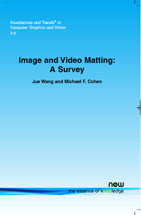Image and Video Matting: A Survey
By Jue Wang, Adobe Systems Incorporated, USA, juewang@adobe.com | Michael F. Cohen, Microsoft Research, One Microsoft Way, USA, michael.cohen@microsoft.com
Abstract
Matting refers to the problem of accurate foreground estimation in images and video. It is one of the key techniques in many image editing and film production applications, thus has been extensively studied in the literature. With the recent advances of digital cameras, using matting techniques to create novel composites or facilitate other editing tasks has gained increasing interest from both professionals as well as consumers. Consequently, various matting techniques and systems have been proposed to try to efficiently extract high quality mattes from both still images and video sequences.
This survey provides a comprehensive review of existing image and video matting algorithms and systems, with an emphasis on the advanced techniques that have been recently proposed. The first part of the survey is focused on image matting. The fundamental techniques shared by many image matting algorithms, such as color sampling methods and matting affinities, are first analyzed. Image matting techniques are then classified into three categories based on their underlying methodologies, and an objective evaluation is conducted to reveal the advantages and disadvantages of each category. A unique Accuracy vs. Cost analysis is presented as a practical guidance for readers to properly choose matting tools that best fit their specific requirements and constraints.
The second part of the survey is focused on video matting. The difficulties and challenges of video matting are first analyzed, and various ways of combining matting algorithms with other video processing techniques for building efficient video matting systems are reviewed. Key contributions, advantages as well as limitations of important systems are summarized.
Finally, special matting systems that rely on capturing additional foreground/background information to automate the matting process are discussed. A few interesting directions for future matting research are presented in the conclusion.
Image and Video Matting
If you've ever wanted to add that missing member of your family to a group photograph, you can now, given newly developed technology. Simply find a picture of the missing person, determine a "matte" that will lift them out and leave the background behind, and use the matte to insert them in the original image. Matting refers to the problem of accurate foreground estimation in images and video. The matte defines which pixels are foreground, which are background, and for pixels along the boundary or in semi-transparent regions such as hair, the matte defines the mixture of foreground and background at each pixel. Matting is one of the key techniques in many image editing and film production applications, thus has been extensively studied in the research literature. With the recent advances of digital cameras, using matting techniques to create novel composites or facilitate other editing tasks has gained increasing interest from both professionals as well as consumers. Consequently, various matting techniques and systems have been proposed to try to efficiently extract high quality mattes from both still images and video sequences.
Image and Video Matting: A Survey provides a comprehensive review of existing image and video matting algorithms and systems, with an emphasis on the advanced techniques that have been recently proposed. Various methods are described and contrasted and finally tested against a uniform set of examples.
Image and Video Matting: A Survey is most appropriate for a graduate level course in computational photography, or for any student or serious practitioner interested in the inner workings of matting methods.
